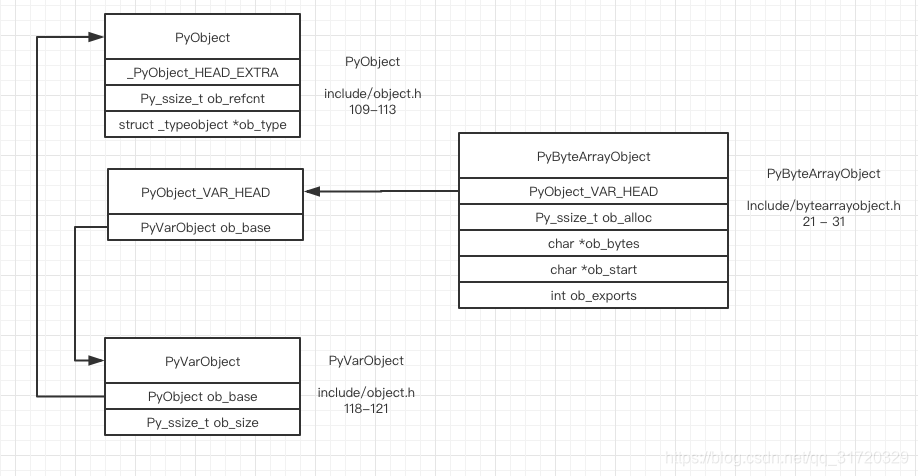- cpython/Objects/bytearrayobject.c
- cpython/Include/bytearrayobject.h
- cpython/Objects/clinic/bytearrayobject.c.h
The ob_alloc field represents the real allocated size in bytes
ob_bytes is the physical begin address, and ob_start is the logical begin address
ob_exports means how many other objects are sharing this buffer, like reference count in a way
>>> a = bytearray(b"")
>>> id(a)
4353755656
>>> b = bytearray(b"")
>>> id(b) # they are not shared
4353755712
after append a charracter 'a', ob_alloc becomes 2, ob_bytes and ob_start all points to same address
a.append(ord('a'))The size grow pattern is shown in the code
/* Need growing, decide on a strategy */
if (size <= alloc * 1.125) {
/* Moderate upsize; overallocate similar to list_resize() */
alloc = size + (size >> 3) + (size < 9 ? 3 : 6);
}
else {
/* Major upsize; resize up to exact size */
alloc = size + 1;
}In appending, ob_alloc is 2, and request size is 2, 2 <= 2 * 1.125, so the new allocated size is 2 + (2 >> 3) + 3 ==> 5
a.append(ord('b'))b = bytearray(b"abcdefghijk")After the slice operation, ob_start points to the real beginning of the content, and ob_bytes still points to the begin address of the malloced block
b[0:5] = [1,2]as long as the slice operation is going to shrink the bytearray, and the new_size < allocate / 2 is False, the resize operation won't shrink the real malloced size
b[2:6] = [3, 4]now, in the shrink operation, the new_size < allocate / 2 is True, the resize operation will be triggered
b[0:3] = [7,8]The growing pattern in slice operation is the same as the append operation
request size is 6, 6 < 6 * 1.125, so new allocated size is 6 + (6 >> 3) + 3 ==> 9
b[0:3] = [1,2,3,4]what's field ob_exports mean ? If you need detail, you can refer to less-copies-in-python-with-the-buffer-protocol-and-memoryviews and PEP 3118
buf = bytearray(b"abcdefg")the bytearray implements the buffer protocol, and memoryview is able to access the internal data block via the buffer protocol, mybuf and buf are all sharing the same internal block
field ob_exports becomes 1, which indicate how many objects currently sharing the internal block via buffer protocol
mybuf = memoryview(buf)
mybuf[1] = 3so does mybuf2 object(ob_exports doesn't change because you need to call the c function defined by buf object via the buffer protocol, mybuf2 barely calls the slice function of mybuf)
mybuf2 = mybuf[:4]
mybuf2[0] = 1ob_exports becomes 2
mybuf3 = memoryview(buf)ob_exports becomes 0
del mybuf
del mybuf2
del mybuf3












